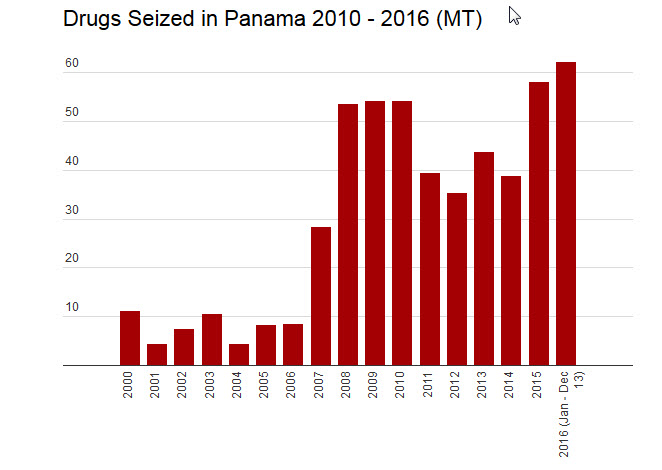Authorities in Panama say they have seized more drugs in 2016 than in any other year since 2000, and soaring cocaine production in neighboring Colombia may be the most likely explanation behind this rise.
As of December 13, authorities had intercepted 62.3 metric tons of cocaine and marijuana — 7 percent more than last year’s total and nearly 60 percent more than in 2014. It also represents the highest annual drug seizure figure since the turn of the century, the Public Security Ministry announced. (See graph below)
Cocaine made up the vast majority — nearly 90 percent — of the seized drugs in 2016, at 55.5 metric tons.
“This was made possible through…more efficient operations, better teams and due to the strategies that we have established in the fight against drug trafficking,” Public Security Minister Alexis Bethancourt said.
The minister praised the results of Operation Shield that ran from May to June 2016, when authorities seized 3 metric tons of cocaine and arrested 300 people suspected of ties to drug trafficking.
He also applauded Operation Homeland, a one-month operation carried out at the end of 2015 which saw the seizure of $1.8 million in cash, and numerous arrests and drug interdictions.
InSight Crime Analysis
As is often the case with drug seizures, Panama‘s record figures could be the result of a variety of dynamics. While stepped-up efforts by the security forces may be part of the answer, it’s likely that higher seizures are also the product of an increase in cocaine passing through the country.
Colombia is the world’s largest cocaine producer, and Panama has historically been its gateway for drugs heading up to the United States. According to the US State Department’s most recent estimates, up to 90 percent of all cocaine entering the country passes through the Central American corridor.
Given its geographic location, Panama is bound to be affected by Colombia’s ongoing explosion in coca crops. Cultivation have soared to double the 2013 levels, and this has been accompanied by record cocaine seizures in the Andean country.
What’s more, officials from the United Nations Office on Drugs and Crime (UNODC) recently told InSight Crime that there are indications that Colombian criminal groups known as “BACRIM” — which are largely responsible for the country’s transnational drug trafficking — have been increasing their presence on the Panamanian border over the past year.
The home base of Colombia’s most powerful BACRIM, the Urabeños, is right along this border region, and the group has long used the Caribbean coast as a departure point for illegal drugs. Despite a large-scale police operation against the Urabeños, a number of huge seizures linked to the group prove that they still have an impressive operational capacity on the drug trafficking front.
Panama’s changing security strategy could also be partly responsible for the record seizures. President Juan Carlos Varela has responded to rising production in Colombia by announcing that interdiction efforts would be bolstered, and the government has allocated funds to set up a new Special Anti-Narcotics Unit.

